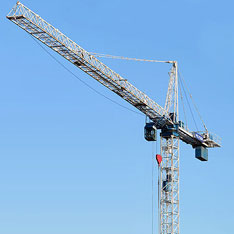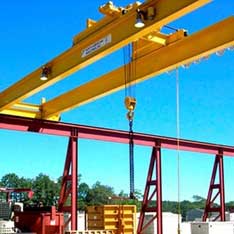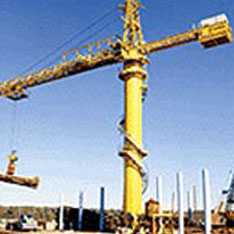Electric Crane Search Result

Tower crane
Tower Crane is a modern form of balance crane that consist of the same basic parts. Fixed to the ground on a concrete slab, tower cranes often give the best combination of height and lifting capacity and are used in the construction of tall buildings. The

EOT Crane
The most adaptable and the most widely used type of power driven crane for indoor service is undoubtedly the three motion Electric Overhead Travelling Crane (EOT crane). It serves a larger area of floor space within its own travelling restrictions than any other permanent type hoisting arrangement. As the name implies, this type of crane is provided with movement above the

Jib Crane
Jib Crane is another important type of bridge construction machinery. Jib cranes derives their name from the horizontal beam, or jib, upon which the shuttle or hoist is mounted. With horizontal load-supporting boom fastened to a rotating vertical column,
FAQ About Electric Crane
- Ceiling Mount Articulating Ceiling Type Jib Crane
- Truck cane standard upperstructure equipment
- Truck Crane Standard Carrier Equipment
- Travelling Cranes
- Overhead Travelling Cranes
- Tower Crane Superstructure
- Safe Crane Operations
- Crane History
- Raw Materials of manufacture cranes
- lifting crab of a EOT crane
- Cranes and hoists operating rules
- Tower-mounted crane
- Mobile Crane Clearance In Tight Quarters
- Single Girder Overhead Cranes and Double Girder Overhead Cranes
- Crane Classification
- Mini crawler cranes
- Tower cranes
- Industrial Cranes
- Jib Cranes
- Crane Control program analysis and comparison
- Electric Hoist Failure Analysis and Treatment
- Metallurgical cranes on the technical requirements for special work
- Crane why not reverse the brakes?
- Customer Order cranes should know a few basic parameters
- Crane Preventive Maintenance Checklist
- Construction Machinery Types and Applications
- Question About Tower Crane - 1
- Bridge and gantry cranes
- Oregon OSHA’s new crane standard for the construction industry
- Standardization of Jib Crane Design by “F.E.M. Rules” And Parametric Modeling
- Crane Component
- Rotary and Rectilinear Cranes
- Electric Overhead Travelling Crane (EOT Crane) Parts
- Articulating Jib Cranes
- Classification of Crane Anti-sway devices
- Rule about marking rated capacity of crane
to allow the jib to swing under an obstruction or outside the normal coverage of a bridge cranePlatform mounting can deliver the benefits or an articulating jib to multiple work cellsEffortless rotationCan be used with hook mounted lifting devices (Electric, air, or vacuum)
level audio visual warning, and Rated Capacity Indicator. Accessories include fire extinguisher, windshield washer/wiper, skylight wiper, left & right hand rear view mirrors, dash and dome lights, and seat belt. Circuit breakers protect Electrical circuits. HYDRAULIC CONTROL VALVES Valves are mounted on the rear of the upperstructure and are easily accessible. Valves utilize electric over hydraulic operators and include one pressure compensated load sensing two spool valve
temperature gauge, dual air pressure gauges. Warning lights include low coolant level, parking brakes on, low air, pumps engaged, and high beam lights. ACCESSORIES Included are Fire extinguisher, right and left hand rear view mirrors, Electric horn, access steps and grab handles (located at six separate points around the crane), back-up alarm, two position boom rack, front and rear towing loops. ACCESSORIES Light package includes headlights with foot operated dimmer switch,
which could obstruct the crane wheels on the tracks must be prevented from finding their way on to the rails, and the rail tracks must be provided with stops or buffers at each extremity to prevent de-railment of the crane. The requirement for Electrically earthing the rail tracks, originally contained under Regulation 7, were superseded by the Electricity at Work (Jersey) Regulations, 1983. In order to meet the requirements of these regulations, the rail tracks must also be "earthed" electrically
crane does not approach within 20' (6100mm) of that place .Various systems of work have been devised to ensure compliance with these requirements. Some examples are as follows -• The temporary construction of stop blocks on the rails and the Electrical isolation of the particular section of the rail track, would be deemed to be effective measures to prevent the crane from approaching within 20' (6100mm) of where personnel are likely to be employed• The placement of explosive detonators
in compliance with European Construction Machinery Stage II. Control System Intelligent computer integrated program control system Is the key technology of the crane. PLC program controller is used, with combination of conventional Electrics, to realize the function of logic control and electronic proportional control of the system, greatly improving safety, reliability and efficiency for crane operation. Crane operation can be shown by a larger computer display, and easy for
the end stops or limit switches Never walk backward when guiding a load Never hoist two or more separately the capacity of the crane even if the combined weight is with in the capacity of the craneNever wrap the hoist line around the load Never Electrical load and/or hoist-limit switches or warning devices Start lifts slowly and avoid shock loading Always place the hook directly over the center of gravity or the designated lifting point Use taglines to help maneuver the load Never use taglines
of a rotating housing containing the boom. Cranes continued to rely on human or animal power until the middle of the nineteenth century, when steam engines were developed. By the end of the nineteenth century, internal combustion engines and Electric motors were used to power cranes. By this time, steel rather than wood was used to build most cranes. During the first half of the twentieth century, European and American cranes developed in different ways. In Europe, where most cranes
the crane, a wide variety of other materials may be used in manufacturing. Natural or synthetic rubber is used to make tires for mobile cranes. Certain structural components may be manufactured from various metals such as bronze and aluminum. Electrical components may include copper for wires and semiconducting elements such as silicon or germanium for electronic circuits. Other materials that may be used include ceramics and strong plastics.
hoisting machinery along the length of the main bridge of the crane. The entire hoisting machinery is mounted on the crab which moves on runner wheel over rails fitted on the main bridge of the crane. The motion of the crab is derived from an Electric motor. A speed reduction gear box and a brake are the essential components of a crab gearing. The motion of the motor is transmitted through the reduction gear box via the brake. The HP of motor is calculated by the formula: W=total
Also, do not work under a suspended load unless the load is supported by blocks, jacks, or a solid footing that will safely support the entire weight. Have a crane or hoist operator remain at the controls or lock open and tag the main Electrical disconnect switch. Ensure that the rated load capacity of a crane's bridge, individual hoist, or any sling or fitting is not exceeded. Know the weight of the object being lifted or use a dynamometer or load cell to determine
with installing and removing a tower crane is small for the self-erecting type but can be considerable for most others. At minimum, those costs would include trucking, hiring a rigging crew and an assist crane, construction of a foundation, Electrical hookup, and the services of a trained technician. More complicated installations such as those which climb have considerable additional expenses. The high costs of installation, as well as the considerable investment of time and planning,
inadequacy. The tail-swing radius may encroach over an active traffic lane or face interference from an obstruction. A large crane can have a rear projecting gantry, strut, backstays, or a live mast capable of fouling trees, buildings, or Electric power lines. Placement of the crane is often close to the face of a building that prevents the tail end from swinging through a full circle. Tail-swing of a live mast or guy struts varies with the boom angle; the full working range of boom
space requirements in new buildings, or expand your usable space in existing buildings. Adjustable torque magnetic disc/shoe brake for smooth operation. Forged steel crane wheels for long life. Top quality hoists matched to the duty required. Electric hoist conforms to IS : 3938. Double Girder Overhead Cranes Capacity Range 1.0 tonne to 150 tonnes Span Range 3 meters to 36 meter Types of Double Girder Overhead Cranes Class I : Light duty cranes for repair shops,
CMAA Crane Classification As to the types of cranes covered under CMAA Specification No. 70 (Top Running Bridge and Gantry Type Multiple Girder Electric Overhead Traveling Cranes), there are six (6) different classifications of cranes, each dependent on duty cycle. Within the CMAA Specification is a numerical method for determining exact crane class based on the expected load spectrum. Aside
crawler cranes Compact and Tough Suits all types of terrain Highly manoeuvrable Super Efficient Ideal for restricted working areas Low overall operating weight Low ground pressure Low headroom for internal and underground use Electric, diesel or propane power sources Quick dispatch by truck to site Capacities upto 8 tonnes
section of mast section(1600*1600 or 1800*1800), good steel performance,complete tower crane is stable and little swing as load.Main material of crane mast section is 160*160*16 angle steel or 125*125*10 buckled square or 135*135*10 steel tube.Electric system adopts domestic fine quality or import components,performance is stable and reliable. Mast section, tie bar, upper and lower bracket and so on, main parts all adopt CO2, GSAW with large in weld penetration, small in transformative.
spend in doing certain tasks. There are many types of cranes and each differs according to its use. Cranes are powered by metal cables, hydraulics system, diesel fuel, etc. These machines can be manipulated remotely using infrared or by photoElectric capability. Cranes that are mechanically operated uses a lever to lift, pivot and to lower the machine. One of the types of cranes is the deck crane. These types of cranes are usually mounted in ports, boats, yachts and cargo ships. There
up to 360 degrees. All crane jibs do not possess arms that are capable of swinging – some are manufactured with fixed arms. In such cases, the lowering and lifting of the loads are most often done with the help of a hoist which is either Electrically or manually controlled. Jib cranes that are fixed to walls or floors generally have limitations on their range of operation and this makes the process of lifting maneuvering bulky objects much easier and safer. It also helps to speed
program falls in heavy, with medium-speed and high-speed gear, energy saving and more reliable. But the rise can not be a stable low-speed, light load can speed, the operation is not convenient. 3. Hydraulic plunger speed Rotor speed access via Electric transformer putting hydraulic brake motor stator, rotor voltage and frequency for motor with its speed and change, so when the motor speed increases, the rotor voltage and frequency reduced accordingly, reduced power f is also reduced thrust
In recent years, the use of Electric hoist to install the increasing volume of production, the gourd is also increasing the number of failures, which not only affects the production of the normal operation of a major accident will lead to serious and how to reduce or prevent accidents,
crane must have the overspeed protection; 6. Hoisting mechanism should have positive and negative contactor fault protection to prevent the loss of power and brake motors are still in power which led to stall occurred; 7. The protection of all Electrical equipment should meet the relevant requirements of the standards; 8. Long-term work in high temperature environment of lifting machinery, electric control device of its protective measures need to be taken; 9. Select occasions for high temperature
transmission. When the shaft is broken, serious, but also can skew deformation of the body; reverse braking system will place the connection gear fierce impact, damage gear, resulting in equipment accident; reverse slam the brakes also make the Electric power generating unit is Large torque and strong currents, a serious burn out the motor. Reverse brakes also make the air cause hanging objects swing hanging objects fall occurred. So, at work, except in case of an accident in order to avoid
1, Electric single-girder crane 2, electric single-girder overhead crane 3, the electric double girder crane 4, the technical parameters Type: Starting weight: () kg; Lifting Height: () m; Span: () m Cart travel distance: () m; specifications:
anti-two block device two block warning / damage device Power Plant (Upper): exhaust system / guards / insulators belts / hoses guards / covers / rotating and reciprocating parts Rotating Upper Structure: turntable Electrical collector ring counterweight frame hydraulic pump(s) hydraulic hoses / tubes / fittings hydraulic pressure electrical wiring main hoist - motor / valves / lines main hoist - wrapping on drum main hoist - minimum (2)
Construction machinery refers to the mechanism used in the project construction. It is widely used in construction, water conservancy, Electric power, roads, mines, ports and national defense sectors etc. Generally speaking, all earthwork construction projects, road construction and maintenance, mobile crane loading and unloading operations and a variety of construction required for
6 years B. 4 yearly, after each erection of crane or after any alterations or repairs C. Yearly If your crane is fitted with a slip ring. This will prevent? A. The crane slipping over B. Rotating the crane more than three times C. The main Electrical cable snapping Limit switches are fitted to all cranes what is the minimum standard of the switches? A. IP60 B. IP65 C. IP67 How often should limit switches be checked? A. Weekly B. Monthly C. Six monthly How often should you
or hoist trolley used to transverse the load • the winch drum and hoist rope • the rope termination points, the hook and hook block, which may contain one or more sheaves • the braking systems • the ‘crane operating area’ • the Electrical supply and its isolation points • the provision of access for service and maintenance/repairs, and • the load limiting devices, which prevent the rated capacity being exceeded.
shovels, excavators, wheel loaders, backhoes, loader backhoes, and track loaders – even when used with chains, slings, or other rigging to lift suspended loads Digger derricks used for augering holes for poles carrying Electric and telecommunication lines, placing and removing the poles, and handling materials installed on or removed from the poles Mechanic’s trucks with hoists used for equipment maintenance and repair only Forklifts, except when they’re
access by using parametric modeling to the available standards may improve speed, reliability and quality of the design procedures. Starting from the fact that components of jib cranes are generally composed of similar mechanical and Electrical sub-components independent of the crane type, a general component tree of jib cranes is developed for automation purpose. Design Modules of cranes are defined from the developed component tree of the cranes based on the available design procedures.
complete component kits for fabrication of economical cranes. BossBuyer crane components allow economic refurbishment of old cranes. Standardized end carriages, standardized wheel bogies, underslung trolleys, drive units with squirrel cage motors, Electric hoists up to 125 t lifting capacity, conductor systems, contactor control panels, radio remote controls, variable frequency speed control equipments, etc. BossBuyer crane components represent many years of experience in combination with permanent
of motive power, viz.: Hand. - When operated by manual power. Power. - When driven by power derived from line shafting. Steam, Eledric, Hydraulic. or Pneumatic. - When driven by an engine or motor attached to the crane, and orated by steam, Electricity, water, or air transmitted to the crane from a xed source of supply. Locomotive. - When the crane is provided with its own boiler or other generator of power, and is self-propelling; usually being capable of both rotary and rectilinear motions. Rotary
A Electric Overhead Travelling Crane (EOT crane) consists of two distinct parts 1. Bridge 2. Crab Bridge: The Bridge consists of two main girders fixed at their ends and connected to another structural components called the end carriages.
hoist unit and a 50% impact factor. All BossBuyer Articulating Jib Cranes are designed for moderate usage. Consult factory for usage other than moderate and all instances of high cycle rates or high impact applications such as high-speed air or Electric hoists, vacuum lifters, or magnets.
entails mechanical complexity and permanent maintenance. The second requires costly auxiliary systems and case by case adjustment. The third is by far the simplest and the easiest to implement. The Anti-Sway solution, provided by Schneider Electric, belongs to this last category. It provides a powerful, economic, maintenance-free response with no need to modify equipment. The originality of this approach is that it works without measuring the actual swaying, by means of an estimator
marked with its individual rated capacity. (2) Each crane designed and manufactured after January 1, 1971 shall have a service class rating as prescribed in “CMAA #70--Specifications for Top Running Bridge and Gantry Type Multiple Girder Electric Overhead Traveling Cranes,†1970 edition, as shown in Appendix B. Additionally the service class rating shall be legibly marked on each crane. (3) Clearance from obstructions shall be a minimum of 3 inches overhead and 2 inches laterally
Relative Searches
Electric Crane, Double Girder Crane, Double Crane, Diesel Crane, Crawler Crane, Electric Crane, Electric Overhead, EOT Crane, Factory Crane, Fixed Crane,

Email: sales@bossbuyer.com
Skype: bossbuyer
Market Hotline
0086-21-61435-919
Service Hotline:
0086-21-61435-919
